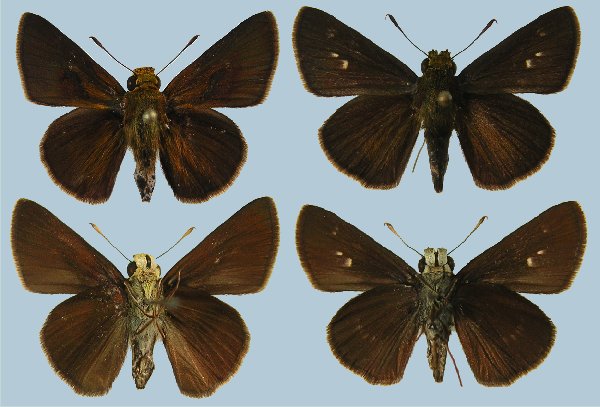Euphyes vestris metacomet

Photo Life History: Euphyes vestris metacomet
Habitat: Wetlands; Valley Lakes & Rivers;
Host Plants: Carex spp.
Suitable Lab Host Plants: Cyperus esculentus, Carex hoodii (Most sedge species of the genus Carex and Cyperus will serve as larval host plants in the lab.)
Caring for Live Female Butterflies: Nectaring techniques
Methods of Female Oviposition: Portable Cages
How to Find Eggs: Look on blades of sedges in wetlands where this skipper flies.
How to Hatch Eggs: Consolidate eggs into one container. Mist spray eggs intermittanly simulating moist, natural conditions in wetlands.
How to Find Caterpillars in the Field: Sedge-feeding Euphyes larvae construct very unique looking skipper nests. Watch this video to see what a late instar nest looks like. They look a little different than grass feeding skipper nests; but the silking and "tying leaves together" are similar. Also see this slide show of skipper nests and scroll down to the 15th slide.
Caterpillar setups: Using the open terrarium or open bucket technique, place hatchling first instars on tender leaves of sedges. Raising late instar caterpillars on potted sedges also works great.
Larva to Pupa: Last instar caterpillars pupate right in their nests.
How to Find Pupae in the Field: Look for evidence of caterpillar feeding by looking for unique nests on sedges. When Euphyes larvae pupate in their nests they plug up the entrance with white silk. Watch this video.
Number of Broods per Year: 1-3; depending upon location.
Overwintering Stage: Third instar.
Overwintering Strategies: Your Own Backyard. (Expose larvae to consistent humidity and airflow.)
Post-Hibernation Strategies: Provide post-diapause third instar caterpillars to healthy host plant.
Avoiding Diapause Techniques: Provide larvae with healthy host plant, high humidity; and/or 24 hours of light. (Long day photophase may not be necessary.)
Disease Prevention: Change out host plant and remove frass every four to five days using the open terrarium technique.
Emergence: Emergence Container
Field Notes: Some late instar larvae from both Northern Virginia and Lake Lewisville, Texas experienced problems with parasitism.

